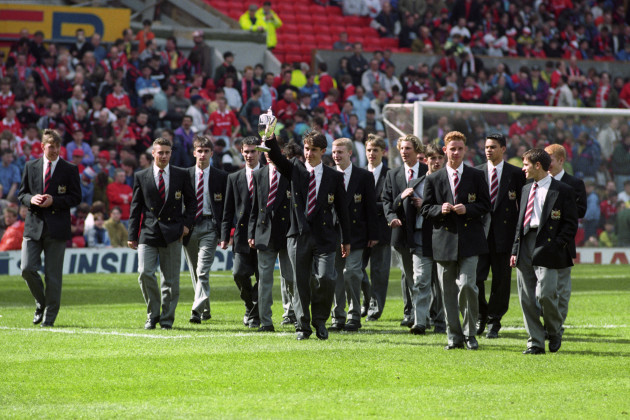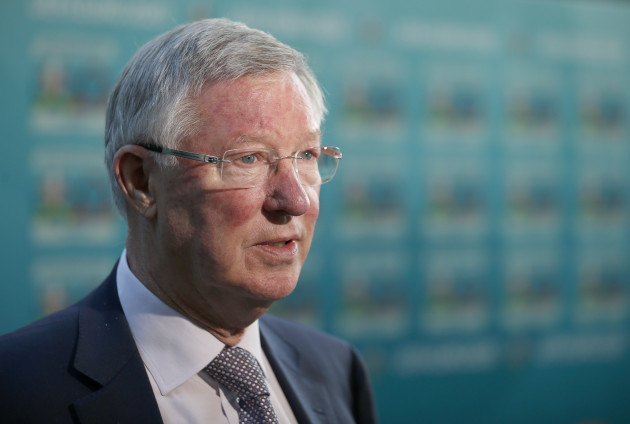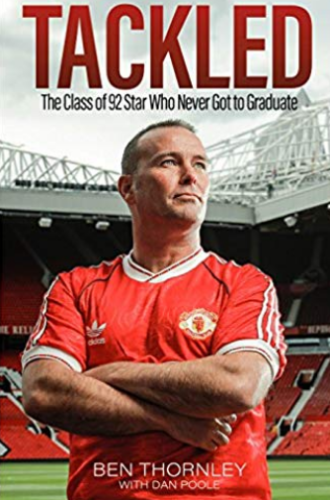THE FOLLOWING PASSAGE is an extract from ‘Tackled: The Class of ’92 Star Who Never Got to Graduate’ by Ben Thornley and Dan Poole.
The room was silent. The game had finished and the other lads were coming in sporadically to see how I was. I was so devastated because I knew I was in a bad way.
The ambulance arrived and took me to Bury General; a short time later I was back in an ambulance to be transferred to Whalley Range, a Bupa hospital. What I find hard to remember is, at what stage did I get out of my kit? At what stage did I have a shower? That’s all a bit of a blur.
At Whalley Range I was examined by Jonathan Noble, Manchester United’s consultant orthopaedic surgeon. He’d been associated with the club for 12 years by that stage and he specialised in knee surgery. When he was called in he was in the middle of a dinner party at his house (though why he was having a dinner party on a Wednesday night, I’ve no idea). When he met me he said, ‘I’ll let you apologise to my wife.’
He had no difficulty making a diagnosis because, in his words, ‘everything was buggered’. He decided to wait until the following morning to operate so that he could carry out the operation with his team – the people who did knee surgery with him week in, week out.
It all started at 6am. Dr Noble says that when he opened up my knee to assess the damage it was like putting a book on its spine and watching all the pages fan out; it had fallen apart, completely smashed to smithereens. He realised that it must have been one hell of an impact. This is what he was greeted by (and this is from my medical records by the way, not off the top of my head):
A rupture of both cruciate ligaments
A complete rupture of the medial collateral ligament
A detachment of the medial meniscus
A complete rupture of the medial capsule of the knee, from the mid-point posteriorly to the patellar ligament anteriorly
A partial tear of the posteromedial hamstring attachment.
All of that from one tackle. That’s a lot. And yet, ironically, Dr Noble tells me that it was one of the easiest major knee-repair operations he ever had to do. Because it was such a mess he could get in without a problem, then get around corners with stitches and whatever else because there wasn’t anything in the way.
While he was in there he repaired everything, which was a bit controversial when it came to cruciates. The common thinking among medical professionals then, and even more so now, was that you shouldn’t repair cruciate ligaments but replace them. But my case was a little different. Normally when cruciate ligaments tear, they explode.
Dr Noble says it looks like spaghetti bolognese because ‘there’s a bit of blood and all these little bits of white string all over the place’. But it turns out that I’ve got good, chunky ligaments and both the anterior and posterior had been pulled off the bone intact, so he reattached them.
To do that he improvised, using a technique he normally used for hand surgery. He drilled holes through the bone, did a sort of criss-cross weave through the ligaments with needle and thread and then pulled them back on to the bone.
Having done that he then repaired my medial cartilage and my meniscus – which went back very nicely, apparently – then my medial ligament and all the other soft-tissue structures on that side of the knee. All up, the operation took him an hour and 20 minutes, despite it being one of the three nastiest knee-ligament injuries he saw during his long and distinguished career.
After the operation he was sceptical that I’d play again because of the extent of the injury. But I was extremely fortunate to have a surgeon who was so good – and that’s a vast understatement. He was exceptionally thorough with everything he did; he wasn’t voted president of the British Association for Surgery of the Knee for nothing.
I remember waking up afterwards with a drip coming from my knee that, when they took it out, was extremely painful. I yelped. No, I screamed. I wasn’t expecting it. My whole leg was in a cast, from my ankle all the way up to the top of my thigh.
It was a strange, uncomfortable feeling and I hated it. I just wanted it off. Even the thought of it now… Not happy times for me at all. A few years later in 1998, when I was at Huddersfield, I broke my foot. I thought, ‘Please don’t say I need a plaster cast.’ Fortunately they gave me one of those Velcro-fastening boots, which was so much better.
Alex Ferguson phoned me to see how I was. He phoned my mum and dad as well (one time he phoned my dad when he was fixing the garage roof but he still took the call). The manager was also in regular contact with Jonathan Noble, who I got in touch with again for the book.
He told me, ‘I’d operated on a lot of Alex’s players but here we were dealing with a young lad and he was obviously terribly worried about you, and needed to talk about it. I can remember one Sunday morning, for example, sitting in his car outside the hospital to discuss your progress. I admired and respected his interest in you; he was more like a concerned uncle than a manager. It just showed what I knew anyway, which is what a decent bloke he was – and is.’
Sadly, Sir Alex Ferguson wasn’t able to get involved with the book in the end. I spoke to him when we played Arsenal at Old Trafford on 29 April; I was pitchside for MUTV doing my little pre-match bit to camera when I spotted him in front of the dugouts. We weren’t live so I asked the camera crew to hang fire for a couple of minutes while I went over to where he was stood with Claire Robson, Bryan Robson’s daughter who works in United’s marketing department.
As I approached, Sir Alex turned to Claire and said, ‘Here’s the lad who would have played for England.’ I briefly outlined what I wanted to talk to him about and he told me to come up to the directors’ room after the game, which I duly did. He invited me in and said, ‘Tell me.’ I explained the format of the book and how honoured I would be if he was willing to contribute his thoughts, to which his exact words were, ‘I can do that for you, son.’
He gave me the number of his secretary in his Wilmslow office so that we could set up a meeting. I left it a couple of days before calling, asked the lady I spoke to if she would pass on my message to Sir Alex and within ten minutes he called. He came up with a few dates off the top of his head that he thought he could do in late May and said he’d ring back later that afternoon with a definitive answer.
Next thing I knew, the news broke that he was in intensive care. I was both astonished and devastated to learn what had happened to him.
It was with great relief that I started to hear from different sources that he was improving, with close friends and family being allowed to visit. But when we tentatively made contact again to see if he was well enough to speak to us we were told that, under doctor’s orders, he wouldn’t be conducting any business until he was fully recuperated and had been on a family holiday. Sadly – in terms of the book – that made it too late for him to contribute.
It’s a huge regret that Sir Alex hasn’t been able to take part. However, the flipside is how happy I am that, at the time of writing, he’s on the mend and will hopefully make a full recovery.
Back to 1994 and after surgery and a night in hospital I was in so much discomfort from the cast that the next morning I asked mum to bring me a knitting needle. She refused so when I got home I found one myself and scratched right down inside. It was such a relief. But when I went back to hospital after about ten days to have my plaster changed (they put me in a normal plaster cylinder, leaving my foot and ankle free) it transpired that I’d pulled out two stitches with the needle.
I’d done it without realising because, even now, there are certain parts of my knee where I don’t have any sensitivity at all. You could stick a pin in (which isn’t an invitation) and I wouldn’t know. Jonathan Noble definitely wasn’t happy about those stitches coming out. Was he fuck.
When I got my plaster changed and saw what was inside, it looked like a chicken leg with a 9.5-inch scar. There was no muscle definition. Your muscles will start to waste even if you only lie in bed for three or four days and I’d noticed that the top of the cast had been getting looser. But actually seeing my leg was awful. It made me cry. I thought, ‘What the fuck has he done to me?’
Before I left hospital I had my first bout of physio, where I was taught exercises for my quads and how to get about on crutches without going arse over tit. Then, a few days later, I was discharged.
When I got home my mum and dad had put a bed downstairs in the dining room for me; most of the time I just lay there, wallowing in my own self-pity.
Hindsight is a wonderful thing but considering how long I was laid up for I probably should have done more – if it happened now I’d start learning a language or something. But it’s difficult when you’re an 18-year-old kid and all you can think about is getting to the stage where you can start rebuilding your leg and getting fit again.
For six weeks I was just a zombie and with being so sedentary, I started putting weight on. I’d been in great condition until that point; there hadn’t been an ounce of fat on me and I was a healthy weight. Yet within the space of a couple of months I put on the best part of a stone, even though I tried to eat the right things. Then I’d look at myself in the mirror and get even more depressed.
Before the injury I was so skinny that I never thought it would happen to me. But then, after a couple of months, you think to yourself, ‘Hang on a minute.’ Once the fat cells had set in during the time I was immobile, my body shape changed from lean to doughnut.
‘Tackled: The Class of ’92 Star Who Never Got to Graduate’ by Ben Thornley and Dan Poole is published by Pitch Publishing. More info here.
Murray Kinsella, Gavan Casey and Andy Dunne preview a big weekend of Heineken Cup action and dissect the week’s main talking points.
Heineken Rugby Weekly on The42 / SoundCloud
Subscribe to our new podcast, Heineken Rugby Weekly on The42, here:




